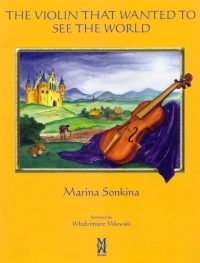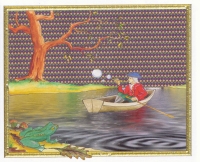| ________________
CM . . .
. Volume XIX Number 12. . . .November 23, 2012.
excerpt:
The Very First Violin was no ordinary fiddle. Without her, the orchestra could not make a sound. She was in charge of the whole orchestra when the conductor was not on the podium. Unfortunately, the conductor was often away sitting on a little boat blowing bubbles and counting acorns. The Violin envied the conductor’s freedom and wished that she could see the world as well! One night, she left her comfortable case and decided to see the world! On her journey, she met some very unusual characters: the squirrel brushing his teeth, the gigantic elephant that soaked her with water, and the wind that broke her strings. She returned to her case at the Opera House. When her Master opened the case the next morning, he was shocked to find a badly damaged “piece of junk.” The Violin was sold to a Gypsy who restored her. Now the Violin could sing again. The Gypsy played her at every opportunity as he traveled throughout the world. The Violin’s dream had come true. She was travelling the world. In a strange twist of fate, many years later the Violin met the Maestro when the Gypsy band played in the Opera House after winning the King’s competition. Marina Sonkina has translated this Russian fairy tale about a wandering violin. The text is very dense for young readers. The pages are full of long paragraphs with a few pictures to illustrate the story. The story revolves around the Very First Violin. She is dissatisfied with her life and wishes to leave the safe and sanitized environment of the Opera House orchestra to travel the world. After a disastrous night on the town where the Violin gets badly damaged, she returns to the safety of her case. However, in her damaged state, her Maestro no longer recognizes her. In fact, he thinks she has been stolen and replaced with this damaged instrument. Ironically, she is sold to a wandering Gypsy who travels the world with her. She has been granted her wish “to see the world.” The illustrations by Wlodzimierz Milewski are reminiscent of the art of illuminated manuscripts. Each “chapter” begins with a large illustrated letter. When the illustrations are larger, they are useful to provide visual interest for the story. However, in many cases, the illustrations are too small to counterbalance the density of the text on each page. This illustrated story could definitely have been improved by more rigorous editing. There are no page numbers. On the very first page, the name of Violin is capitalized in the first sentence, and then later on, is not capitalized. The paragraphs are often long, and grammatical constructions are confusing, i.e. “Some of his bubbles came out round like eyes, others – long like sausages.” Many strange events are simply unexplained. A squirrel appears brushing his teeth. He says to the Violin, “What a strange instrument this one is. Not a banjo, not a bass, not an oboe, nor a Japanese flute…Could it be a rattle?” He then disappears. Why is he there? What purpose does the squirrel serve to the plot? Although the Violin’s story of growing self-awareness could have been a good one, the lack of editing detracts from the effectiveness of this book. Not Recommended. Myra Junyk, who lives in Toronto, ON, is a literacy advocate and author.
To comment
on this title or this review, send mail to cm@umanitoba.ca.
Copyright © the Manitoba Library Association. Reproduction for personal
use is permitted only if this copyright notice is maintained. Any
other reproduction is prohibited without permission.
NEXT REVIEW |
TABLE OF CONTENTS FOR THIS ISSUE
-November 23, 2012.
AUTHORS |
TITLES |
MEDIA REVIEWS |
PROFILES |
BACK ISSUES |
SEARCH |
CMARCHIVE |
HOME |

